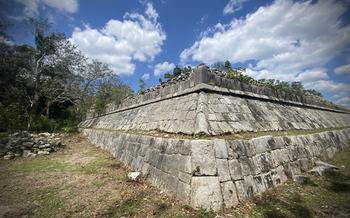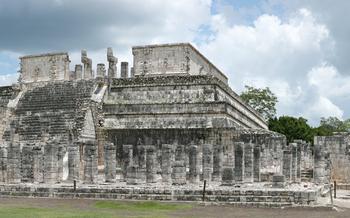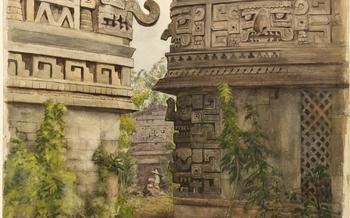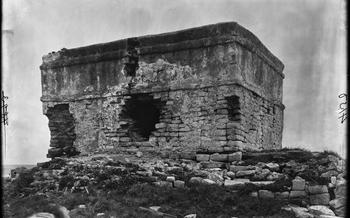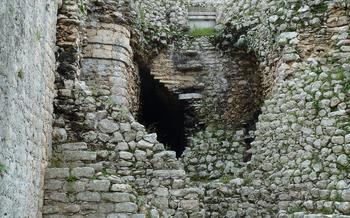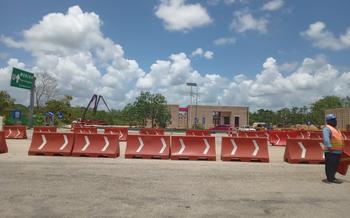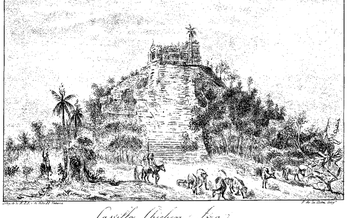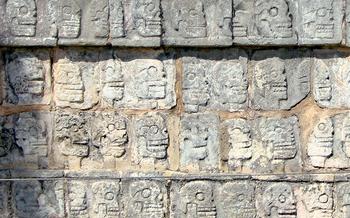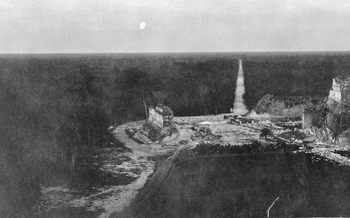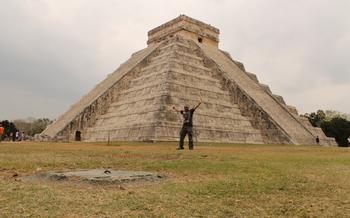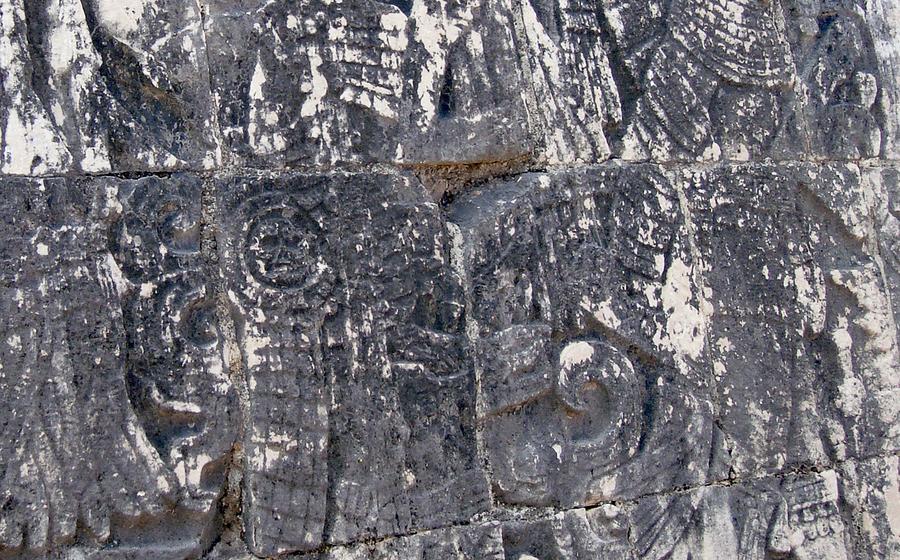
The Great Ball Court
- Chichén Itzá: An Enigmatic Legacy
- Unveiling the Great Ball Court
- Immerse in the Architectural Marvel
- Unraveling the Mystical Traditions
- Discovering the Ball Court's Purpose
- Evaluating the Archaeological Treasures
- Experiencing the Court's Acoustics
- Engaging in Interactive Activities
- Exploring the Surroundings
- Tips for a Memorable Visit
- Historical Context and Timeline
- Archaeological Research and Discoveries
- Conservation and Preservation Efforts
- Cultural Significance and Identity
- Insider Tip: Exploring Beyond the Main Tourist Areas
Chichén Itzá: An Enigmatic Legacy
Nestled in the lush Yucatán Peninsula, Chichén Itzá stands as a testament to the grandeur and ingenuity of the ancient Maya civilization. This enigmatic city, once a thriving metropolis, boasts a rich history steeped in mystery and intrigue. Its iconic structures, including the Great Ball Court, offer a glimpse into the advanced culture that flourished here centuries ago.
Chichén Itzá's legacy is intertwined with the Itza and Maya civilizations. The Itza, a Maya subgroup, arrived in the region around the 10th century and established their capital at Chichén Itzá. Under their rule, the city flourished, becoming a significant political, economic, and religious center.
The city's impact on Mesoamerican history was profound. Chichén Itzá became a hub for trade and cultural exchange, connecting the Maya with other Mesoamerican civilizations. Its influence extended far beyond its borders, leaving an indelible mark on the region's history and culture.
In recognition of its outstanding universal value, UNESCO designated Chichén Itzá as a World Heritage Site in 198This prestigious accolade underscores the site's cultural and historical significance and ensures its protection and preservation for future generations.
Unveiling the Great Ball Court
At the heart of Chichén Itzá, the Great Ball Court stands as a testament to the Maya civilization's architectural prowess and cultural significance. This colossal court, measuring an impressive 168 meters in length and 70 meters in width, is the largest of its kind in Mesoamerica. Its sheer dimensions, coupled with its precise layout and orientation, hint at the profound importance it held within Maya society.
The ball court's north-south orientation, aligned with the cardinal points, suggests its connection to celestial events and astronomical observations. The court's long, narrow shape and sloped sides create an amphitheater-like setting, enhancing the acoustics and allowing spectators from all angles to witness the spectacle unfolding within.
Beyond its physical dimensions, the ball game itself, known as Pok-ta-Pok, was deeply embedded in Maya culture and mythology. It was more than just a sport; it held ritual significance, intertwined with religious beliefs, social hierarchy, and power dynamics. Each match was a symbolic battle, a contest between opposing forces representing the cosmos, the underworld, and the struggle between light and darkness. The court served as a sacred stage where these symbolic battles played out, with the outcome having profound implications for the community's well-being and prosperity.
Immerse in the Architectural Marvel
The Great Ball Court of Chichén Itzá stands as a testament to the architectural prowess of the Maya civilization. Its sheer size and intricate details captivate visitors, leaving them in awe of its grandeur. The court's dimensions are staggering, measuring 168 meters in length, 70 meters in width, and 12 meters in height. The playing field is flanked by two massive parallel walls, each topped with a sloping terrace. These terraces served as spectator stands, allowing thousands of spectators to witness the thrilling ball games.
The construction of the ball court demonstrates the Maya's engineering expertise. The walls are built using the corbelled arch technique, where each layer of stone slightly overhangs the one below, creating a stable and durable structure without the use of mortar. The court's orientation is also significant, as it aligns with the cardinal directions, suggesting the Maya's understanding of astronomy and celestial events.
The ball court is adorned with exquisite carvings and iconography, each holding symbolic and cultural meaning. The walls are decorated with intricate reliefs depicting scenes of the ball game, as well as mythical creatures and deities. These carvings provide valuable insights into Maya mythology, beliefs, and artistic traditions. The court's iconography also includes representations of the Maya calendar, symbolizing the cyclical nature of time and the importance of celestial events in Maya culture.
Standing within the Great Ball Court, one cannot help but be overwhelmed by its sheer presence. The towering walls, the expansive playing field, and the intricate carvings create an awe-inspiring atmosphere that transports visitors back in time to the days when the court was a hub of activity, echoing with the cheers of spectators and the rhythmic bounce of the rubber ball.
Unraveling the Mystical Traditions
Beyond its architectural grandeur, the Great Ball Court at Chichén Itzá holds deep spiritual and cultural significance. It was the stage for the sacred ball game known as "Pok-ta-Pok," a ritual deeply embedded in Maya mythology and cosmology.
The game, played by two teams, involved hitting a solid rubber ball with the hips, elbows, or knees, aiming to pass it through a stone ring mounted high on the court walls. The rules were complex, and the outcome had divinatory implications, often linked to agricultural cycles and the well-being of the community.
Players wore protective gear, including thick leather padding and helmets adorned with feathers and jade ornaments. The game was not merely a sport but a sacred ritual, a reenactment of the mythical struggle between the Hero Twins, Hunahpu and Xbalanque, against the Lords of the Underworld.
The court's acoustics enhanced the game's dramatic effect. The ball's impact against the stone walls created a resounding echo, adding to the mystical atmosphere. The game was accompanied by music, chanting, and the roar of the crowd, creating a sensory spectacle that transported participants and spectators to the realm of the sacred.
Discovering the Ball Court's Purpose
Beyond its sporting function, the Great Ball Court held profound cultural and religious significance for the Maya. It served as a microcosm of ancient Maya society, reflecting its power dynamics and social hierarchy. The court was a stage for political gatherings and negotiations, where rulers and dignitaries convened to discuss matters of state and forge alliances. It was also a venue for religious rituals and ceremonies, including sacrifices and offerings to the gods. The ball game itself was believed to have a spiritual dimension, representing the cosmic battle between light and darkness and the cyclical nature of life and death. The court's alignment with celestial bodies and the symbolism embedded in its iconography further reinforced its sacred character.
Evaluating the Archaeological Treasures
Excavations and restoration efforts at the Great Ball Court have uncovered a wealth of archaeological treasures, providing valuable insights into the lives, customs, and beliefs of the ancient Maya. Artifacts such as ceramic vessels, stone tools, and jade ornaments have been discovered, shedding light on the material culture of the Maya. Sculptures and hieroglyphic inscriptions adorn the walls of the court, narrating historical events, mythological tales, and the achievements of Maya rulers. These inscriptions have played a crucial role in deciphering the Maya writing system and understanding their complex calendar and astronomical knowledge. The ball court at Chichén Itzá serves as a window into ancient Mesoamerican culture, allowing us to glimpse into the vibrant world of the Maya civilization.
Experiencing the Court's Acoustics
Beyond its architectural and historical significance, the Great Ball Court offers a unique acoustic experience. The court's design and construction create exceptional reverberation, giving rise to the famous 'whisper effect.' Stand at one end of the court and whisper against the wall; your words will carry clearly to the opposite end, as if spoken directly into someone's ear. This phenomenon, scientifically explained by the court's shape and dimensions, served as an ancient communication technique and crowd control mechanism. The acoustics of the Great Ball Court add an enchanting dimension to the site, making it a marvel not only for the eyes but also for the ears.
Engaging in Interactive Activities
Chichén Itzá offers a range of interactive activities that bring the ancient Maya culture to life for visitors of all ages. Guided tours led by knowledgeable experts provide in-depth insights into the history, significance, and symbolism of the Great Ball Court. Educational programs and workshops allow visitors to learn about Maya customs, traditions, and games through hands-on experiences. Immersive exhibits and multimedia presentations transport visitors back in time, showcasing the vibrant world of the ancient Maya. These interactive activities create a memorable and engaging experience, fostering a deeper understanding and appreciation for this remarkable site.
Exploring the Surroundings
Chichén Itzá is more than just the Great Ball Court; it's a sprawling archaeological site teeming with iconic landmarks and hidden gems. Embark on a journey to discover the majestic Kukulkan Pyramid, a towering testament to ancient Maya ingenuity. Climb its steep steps and marvel at the incredible views from the top, where you can admire the surrounding jungle canopy and the Great Ball Court from a unique perspective.
Venture beyond the main tourist areas and explore the lesser-known corners of Chichén Itzá. Discover the intricately carved Temple of the Warriors, with its rows of imposing columns and well-preserved murals depicting fierce battles and mythological scenes. Immerse yourself in the tranquil atmosphere of the Sacred Cenote, a natural well where the Maya performed rituals and ceremonies.
Exploring the surroundings of Chichén Itzá offers a well-rounded travel experience, allowing you to delve deeper into the Maya civilization's rich history and culture. Immerse yourself in the natural beauty of the Yucatán Peninsula, with its lush jungles, sparkling cenotes, and diverse wildlife. Discover the vibrant local culture, savor the delicious cuisine, and engage with the friendly people who call this region home. Create a memorable and enriching journey that extends beyond the boundaries of the Great Ball Court.
Tips for a Memorable Visit
To make the most of your visit to the Great Ball Court, careful planning and preparation are essential. Firstly, aim to arrive early in the morning or late in the afternoon to avoid the midday heat and crowds. Wear comfortable shoes and clothing suitable for walking on uneven surfaces. Sun protection is crucial, so bring a hat, sunglasses, and sunscreen. Stay hydrated by carrying water or purchasing it from vendors. Pack snacks if needed, as food options may be limited.
To capture the essence of your visit, bring a camera to document the court's grandeur and intricate details. Be mindful of cultural norms by dressing respectfully and refraining from climbing or touching the ancient structures. Lastly, remember that the Great Ball Court is a sacred site, so maintain a respectful demeanor and observe any posted regulations or guidelines.
Historical Context and Timeline
The Great Ball Court of Chichén Itzá was constructed during the Terminal Classic period (800-1000 CE), a time of significant cultural and political transformation in Mesoamerica. The Itza, a Maya subgroup, emerged as a dominant force in the region, establishing Chichén Itzá as their capital city. Under their rule, the city flourished, becoming a major center of trade, pilgrimage, and ritual activity. The ball court played a central role in this vibrant urban environment, serving as a stage for both sporting events and sacred ceremonies.
Following the decline of the Itza in the 13th century, Chichén Itzá was abandoned and fell into disrepair. The ball court, like many other structures, was reclaimed by the jungle and remained hidden for centuries. It wasn't until the late 19th century that explorers and archaeologists began to rediscover and excavate the ruins of the city, including the Great Ball Court. The site's designation as a UNESCO World Heritage Site in 1988 further solidified its importance as a cultural and historical treasure.
Today, the Great Ball Court stands as a testament to the ingenuity and artistry of the ancient Maya. It remains one of the most iconic and well-preserved structures at Chichén Itzá, attracting millions of visitors each year who come to marvel at its grandeur and learn about its rich history.
Archaeological Research and Discoveries
Over the years, extensive archaeological research and excavations have been conducted at the Great Ball Court, shedding light on its history, significance, and the broader context of Maya civilization. Archaeologists have unearthed a wealth of artifacts, including stone sculptures, ceramic vessels, and hieroglyphic inscriptions, which provide valuable insights into the lives, customs, and beliefs of the ancient Maya. These discoveries have helped to piece together the history of the ball court, its role in Maya society, and its relationship to other important sites within Chichén Itzá.
Ongoing excavations and studies continue to uncover new findings and insights, enriching our understanding of the ball court and its place in Mesoamerican history. Archaeological research at the site has revealed evidence of earlier construction phases, suggesting that the ball court was modified and expanded over time, reflecting the changing needs and beliefs of the Maya population. The ongoing exploration of the ball court and its surroundings promises to shed further light on the cultural and historical significance of this iconic landmark.
Conservation and Preservation Efforts
The Great Ball Court at Chichén Itzá, a UNESCO World Heritage Site, has undergone extensive conservation and preservation efforts to ensure its longevity and accessibility. Recognizing the site's immense historical and cultural significance, authorities have implemented measures to protect it from natural elements, human impact, and the passage of time.
Conservation efforts include regular maintenance and repairs to address structural issues, erosion, and vegetation growth. Archaeological research and excavations are carefully conducted to minimize disturbance to the site while uncovering new insights into its history. The surrounding environment is also taken into account, with measures to prevent soil erosion and preserve the natural beauty of the area.
Balancing tourism with conservation is a crucial aspect of preserving the Great Ball Court. Visitor traffic can cause wear and tear on the site, and managing the flow of tourists is essential to minimize impact. Controlled access, designated pathways, and educational programs help ensure that visitors can appreciate the site's grandeur while respecting its fragility.
Sustainable tourism practices are promoted to reduce the environmental footprint of tourism at Chichén Itzá. This involves implementing waste management systems, encouraging responsible behavior among visitors, and supporting local communities in developing sustainable tourism initiatives. By promoting responsible stewardship, conservation efforts aim to preserve the Great Ball Court for future generations to admire and learn from.
Cultural Significance and Identity
The Great Ball Court of Chichén Itzá holds immense cultural significance as a symbol of Mexican history and cultural heritage. Its iconic status and profound historical roots have made it a source of pride and inspiration for the Mexican people. The court represents the ingenuity, artistry, and rich traditions of the ancient Maya civilization, which continues to influence contemporary Mexican culture.
Furthermore, the Great Ball Court plays a crucial role in the identity of modern-day Maya communities, who regard it as a tangible link to their ancestral past. The court serves as a reminder of the resilience and cultural continuity of the Maya people, who have preserved their traditions and customs despite centuries of colonization and assimilation.
Promoting cultural tourism and responsible stewardship is essential to preserving the legacy of the Great Ball Court and ensuring its significance for future generations. By embracing sustainable tourism practices and promoting cross-cultural understanding, visitors can contribute to the preservation of this iconic site while also gaining a deeper appreciation for the rich cultural heritage of Mexico.
Insider Tip: Exploring Beyond the Main Tourist Areas
While Chichén Itzá's main attractions, like the Great Ball Court and the Kukulkan Pyramid, are captivating, venturing beyond the tourist crowds can lead to hidden gems. Explore lesser-known cenotes tucked away in the lush jungle, such as Cenote Xcajum or Cenote Suytun, where you can swim in crystal-clear waters and marvel at the stunning rock formations. Visit nearby archaeological sites like Ek Balam or Cobá, where you can climb ancient pyramids and immerse yourself in the history of the Maya civilization. Discover the authentic charm of the Yucatán Peninsula by exploring local villages, sampling traditional cuisine, and interacting with the friendly locals. Embark on a unique and unforgettable travel adventure that combines history, nature, and culture, creating lasting memories that go beyond the surface of this extraordinary region.
